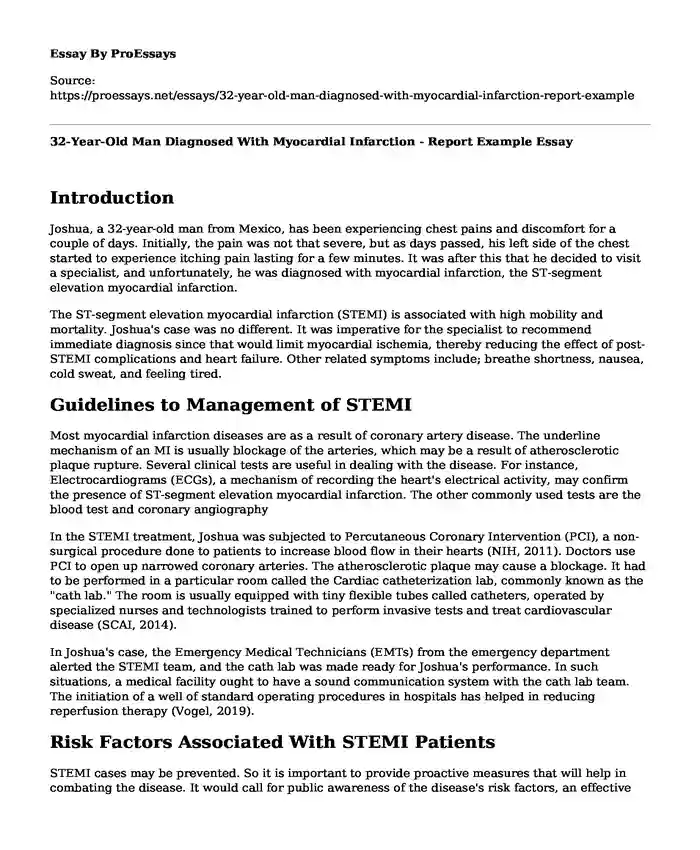Introduction
Joshua, a 32-year-old man from Mexico, has been experiencing chest pains and discomfort for a couple of days. Initially, the pain was not that severe, but as days passed, his left side of the chest started to experience itching pain lasting for a few minutes. It was after this that he decided to visit a specialist, and unfortunately, he was diagnosed with myocardial infarction, the ST-segment elevation myocardial infarction.
The ST-segment elevation myocardial infarction (STEMI) is associated with high mobility and mortality. Joshua's case was no different. It was imperative for the specialist to recommend immediate diagnosis since that would limit myocardial ischemia, thereby reducing the effect of post-STEMI complications and heart failure. Other related symptoms include; breathe shortness, nausea, cold sweat, and feeling tired.
Guidelines to Management of STEMI
Most myocardial infarction diseases are as a result of coronary artery disease. The underline mechanism of an MI is usually blockage of the arteries, which may be a result of atherosclerotic plaque rupture. Several clinical tests are useful in dealing with the disease. For instance, Electrocardiograms (ECGs), a mechanism of recording the heart's electrical activity, may confirm the presence of ST-segment elevation myocardial infarction. The other commonly used tests are the blood test and coronary angiography
In the STEMI treatment, Joshua was subjected to Percutaneous Coronary Intervention (PCI), a non-surgical procedure done to patients to increase blood flow in their hearts (NIH, 2011). Doctors use PCI to open up narrowed coronary arteries. The atherosclerotic plaque may cause a blockage. It had to be performed in a particular room called the Cardiac catheterization lab, commonly known as the "cath lab." The room is usually equipped with tiny flexible tubes called catheters, operated by specialized nurses and technologists trained to perform invasive tests and treat cardiovascular disease (SCAI, 2014).
In Joshua's case, the Emergency Medical Technicians (EMTs) from the emergency department alerted the STEMI team, and the cath lab was made ready for Joshua's performance. In such situations, a medical facility ought to have a sound communication system with the cath lab team. The initiation of a well of standard operating procedures in hospitals has helped in reducing reperfusion therapy (Vogel, 2019).
Risk Factors Associated With STEMI Patients
STEMI cases may be prevented. So it is important to provide proactive measures that will help in combating the disease. It would call for public awareness of the disease's risk factors, an effective method to educate the public.
Other Traditional Risk Factors
Amongst other, high sensitivity C - reactive protein and fasting blood glucose. Joshua may have had experienced smoking and diabetes as risk factors. Studies show that although diabetes is a risk factor, it is not that significant in younger patients. Diabetes increases the level of blood sugar, thereby compromising glucose tolerance and insulin resistance (Yunyun, 2014). As fasting blood sugar may be an independent risk factor, guardians and parents should regulate their children's sugar consumption. Pre diabetic conditions may influence the course of STEMI; it is advisable to contact medical facilities for proper checkup. Although Joshua experienced pain for some time before the intervention of medical assistance, the doctors in question recommended that it was better than he would have gone earlier in advance.
Conclusion
As the saying states, prevention is better than cure. Therefore, preventive measures awareness is a crucial step in dealing with STEMI. Some of the preventive measures include acquiring medical assistance in lowering blood pressure, low alcohol consumption since alcohol may raise blood pressure and cause diseases like increased cardiomyopathy, which may lead to stroke. One is recommended to take food rich in vitamins, minerals, and fiber. Physical fitness is also a necessity.
Mentioned above are some of the preventive measures to adopt. Joshua may not have known STEMI, but after he consulted with doctors, preventive measures listed above were now his way of life.
References
Bruggmann, C., & Iglesias, J. (2020). Long-Term Quality of Prescription for ST-Segment Elevation Myocardial Infarction (STEMI) Patients: A Real World 1-Year Follow-Up Study. Retrieved 12 July 2019, from: https://link.springer.com/article/10.1007%2Fs40256-019-00361-5.
Myocardial infarction. (2020). Retrieved 11 August 2020, from
https://en.wikipedia.org/wiki/Myocardial_infarction.
NIH, N. (2020). Percutaneous Coronary Intervention | NHLBI, NIH. Nhlbi.nih.gov. Retrieved 11 August 2020, from https://www.nhlbi.nih.gov/health-topics/percutaneous-coronary-intervention.
Vogel, B. (2019). ST-segment elevation myocardial infarction. Nature Reviews Disease Primers, 5(1). https://doi.org/10.1038/s41572-019-0090-3.
Yunyun, W. (2014). Analysis of risk factors of ST-segment elevation myocardial infarction in young patients. BMC Cardiovascular Disorders, 14(1).
https://doi.org/10.1186/1471-2261-14-179.
Cite this page
32-Year-Old Man Diagnosed With Myocardial Infarction - Report Example. (2023, Nov 06). Retrieved from https://proessays.net/essays/32-year-old-man-diagnosed-with-myocardial-infarction-report-example
If you are the original author of this essay and no longer wish to have it published on the ProEssays website, please click below to request its removal:
- Comparison of Statistical Studies
- The American Health Care and the Importance of Psychology in Child Development
- Nursing Essay Example: Developing Nursing Care Plan
- Essay in Social Marketing: Change 4 Life and Obesity Crisis
- Paper Example on Teenage Mothers & Low-Income Communities: Experiences of Teen Pregnancy
- Essay on Inclusive Education: Achieving Social & Academic Success for Children With Disabilities
- Paper Sample on Elderly Home Care: Inpatient Education for Safety







